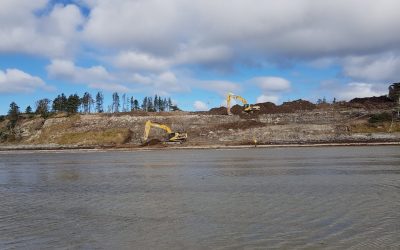PROJECT
Remediation of a federal site impacted by petroleum hydrocarbons (PHCs) and chlorinated volatile organic compounds (cVOCs)
SERVICE
INDUSTRY
Gourvernmental
PROJECT LOCATION
London, Ontario
PROJECT DATE
2020
QUANTITY
CHALLENGES
BACKGROUND
The Highbury Complex was first established in the early 1940s for assembly operations. Operations included maintenance, supply, transport, repair, refitting, storage, and fueling of military vehicles and equipment. Several former buildings on the property were used for a variety of purposes, including a paint shop, vehicle and equipment storage, mechanical assembly, and refitting of heavy military vehicles. The buildings were demolished in 2012.
SANEXEN was retained as the general contractor for the project and was ultimately responsible for implementing the entire contract and executing all project work.
SOLUTION
The work included overall project management and reporting, as well as ensuring that all SANEXEN subcontractors carried out work elements according to the main contract. SANEXEN was also responsible for developing and implementing the site-specific plans (Health & Safety, Environmental Management, Emergency Response), and implementing its corporate QA/QC, EHS, and Project Management systems.
Prior to the excavation work, public and private utilities were located, contaminated soils were identified, concrete foundations and structures were removed, and drainage systems were installed along the perimeter of each excavation in an effort to lower the groundwater table to below the depth of soils to be excavated.
Each excavation zone was drained and dewatered, and the water was pumped to Sanexen’s custom built mobile WTU for treatment to applicable standards prior to discharge.
Environmental protection measures included the installation of silt fences to divert natural run off from contaminated areas and soil stockpiles, the use of geomembranes to protect non contaminated surfaces, and air monitoring.
PROJECT HIGHLIGHTS
- Excavation of approximately 136,000 m³ of soils, of which 55,800 m³ were below the groundwater table;
- Treatment of 43,950,000 litres of contaminated water;
- Collection of 250 water and 5,350 soil samples for laboratory analyses;
- Backfilling of 117,300 m³ using previously excavated soils that met the applicable soil criteria and 44,000 m³ of clean imported backfill.
INTERESTED IN WORKING WITH US?
Contact us to learn more.
SEE SIMILAR PROJECTS
Clean-up and remediation of the former Cap-Blanc Landfill, Anticosti Island
PROJECTSERVICEEnvironmental Site RemediationINDUSTRYMunicipalPROJECT LOCATIONAnticosti Island, QcPROJECT DATE2022QUANTITY123 m3 of soil disposedCHALLENGESThe main challenges consisted in stabilizing the oceanfront embankment and disposing of the soils and materials by...
Environmental Remediation – Dew Line, Cape Dyer, Nunavut
PROJECTSERVICEEnvironmental Site RemediationINDUSTRYMilitaryPROJECT LOCATIONCape Dyer, NunavutPROJECT DATE2004-2011QUANTITY1,400,000 L of water treatedCHALLENGESDYE-Main Cape Dyer was part of the DEW Line Site, built in the 1950’s as part of the effort to protect...



